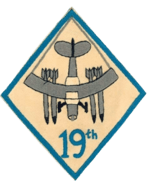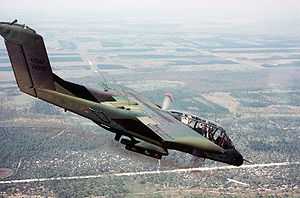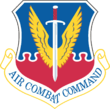19th Weapons Squadron
| 19th Weapons Squadron | |
|---|---|
|
Major William Fry, 19th Weapons School instructor and director of operations, explains to Senior Airman Brandi Gilstrap about the specs of an air-to-ground munition | |
| Active | 1942–1945; 1963-1964; 1964-1993; 2003-present |
| Country |
|
| Branch |
|
| Type | Squadron |
| Role | Advanced Intelligence, Surveillance, and Reconnaissance Training |
| Part of | USAF Weapons School |
| Garrison/HQ | Nellis Air Force Base, Nevada |
| Motto | "Rustic" |
| Engagements |
Vietnam War |
| Decorations |
Distinguished Unit Citation (3x) Air Force Outstanding Unit Award with Combat "V" Device (4x) Air Force Outstanding Unit Award (6x) Republic of Vietnam Gallantry Cross with Palm Republic of Korea Presidential Unit Citation |
| Insignia | |
| 19th Weapons Squadron emblem |
 |
The 19th Weapons Squadron is a non-flying United States Air Force unit, assigned to the USAF Weapons School at Nellis AFB, Nevada.
The squadron was first activated as the 19th Observation Squadron in March 1942. The 19th originally flew antisubmarine missions during World War II, then moved to China in 1944 to begin observation missions in support of Chinese ground forces. It later flew resupply missions to resistance forces operating behind enemy lines in French Indochina.
The squadron was redesignated the 19th Tactical Air Support Squadron, then organized in July 1963. From 1963 through 1968 the 19th Tactical Air Support Squadron flew forward air support and observation missions over Vietnam until its mission was transferred to Osan AB, South Korea in 1972, where it provided Eighth US Army and Republic of Korea ground forces with aerial reconnaissance and close air support.
Overview
The squadron has two syllabi, the Intelligence Weapons Instructor Course and the Intelligence Sensor Weapons Instructor Course, and a flight that supports mission planning for 17,000 sorties annually.
History
World War II
Activated as the 19th Observation Squadron (Light) on 5 Feb 1942. The squadron activated on 2 Mar 1942 at Miami Municipal Airport as part of the Air Force Combat Command. Five days later, it moved to Jacksonville Municipal Airport, Florida. Two days after that, it became part of Army Air Forces. On the 29th, it became part of the 66th Observation Group.
It moved to Pope Army Airfield, North Carolina on 11 May 1942. While there, it was redesignated as the 19th Observation Squadron. On 19 October 1942, it moved to Morris Field, North Carolina. On 2 April 1943, it changed name once again, to 19th Liaison Squadron. The following day, it transferred bases to Camp Campbell, Kentucky. On 22 June 1943, it changed airfields once more, to Aiken Army Airfield, South Carolina. On 11 August 1943, it was assigned to I Air Support Command.
It flew anti-submarine missions using A-20 Havocs, B-25 Mitchells, and O-52 Owls, while undergoing observation training at these various bases in the southeastern states. They used L-1 Vigilants, L-2 Grasshoppers, Aeronca L-3s, L-4 Grasshoppers, L-5 Sentinels, L-6 Grasshoppers, and Douglas O-46s for observation sorties. P-39 Airacobras, P-43 Lancers, and P-51 Mustangs were also in the squadron aircraft inventory.
From Aiken, the squadron shipped cross-country to Camp Anza, California, arriving on 28 March 1944. This was a transit base for the squadron, as it shipped out to Bombay (now Mumbai), India. It arrived in India on 9 April, and was attached to U.S. Army Forces, China-India-Burma. It spent an itinerant few weeks further training in India, moving through Kanchrapara and Ondal, to land in Chabua on 17 May.
It then moved onward to Kunming, China arriving on 29 May 1944. They were attached to Y Force, to begin observation missions in support of Chinese Nationalist ground forces. They supported Y Force until 8 August. Their American parent unit would be variously Fourteenth Air Force and the 69th Composite Wing.
At various times, the 19th operated detachments from Kunming, Poashan, Wenshan, Yunnanyi, Chihkiang, Kweiyang, and Liuchow. It moved bases to Chengkung on 28 March 1945. After March 1945, the squadron carried mail and passengers to American liaison personnel in South China, and the 19th flew re-supply missions to resistance forces operating behind enemy lines in French Indochina.
On 1 August, the 19th was placed under operational control of Tenth Air Force. Shortly after the Japanese surrendered, on 18 August 1945, the 19th moved to Nanning, China. From there it returned via Calcutta, India to the U.S., where it inactivated on 1 Dec 1945 at Fort Lewis, Washington.[1]
Vietnam War








The 19th TASS was the first Forward Air Control squadron assigned to the Vietnam War. It began with O-1 Bird Dogs transferred from army aviation.[2]
The squadron was activated at Bien Hoa, Vietnam on 17 June 1963, under Pacific Air Forces. The unit's original mission was support of the South Vietnamese Air Force; it also trained Vietnamese pilots and observers. Besides forward air control and artillery control, it performed a multiplicity of other roles: psychological warfare, radio relay, and resupply missions, as well as aerial escort for convoys, helilifts, and trains.

It was assigned to the 34th Tactical Group, 8 July 1963 through 8 August 1964.[3] It was during this time that Richard Whitesides was the first FAC of the Vietnam War to win the first Air Force Cross, on a mission near Khe Sanh.[4] Its original mandate was a one year assignment to train the VNAF, with the 19th's O-1's to be turned over to the South Vietnamese at the end of the year. The Tonkin Gulf incident scotched those plans.[5] One of the additional missions was flying support and forward air control for Project DELTA in their covert insertions into Laos. They began this secretive mission in July 1963, and carried it out until the 21st TASS took over the role.[6]
The 19th served in its roles until 8 August 1964, when it was briefly inactivated. It was reactivated on 16 October 1964, once again under Pacific Air Forces; it was reassigned to the 34th Tactical Group, 21 October 1964.[3] In this incarnation, its principal mission was visual reconnaissance and forward air control of fighter-bombers, although it continued to train Vietnamese pilots and observers. It was shifted to the 6251st Tactical Fighter Wing on 8 July 1965. Shortly thereafter, on 8 November 1965, it was transferred to the 505th Tactical Air Support Group.[3] The 19th TASS began flying actual forward air control sorties out of Bien Hoa on 11 November 1965, using the call sign Sidewinder.[7] By July 1966, the 19th was parceled out among numerous forward operating locations in III Corps and II Corps. While serving as Forward Air Controllers and/or Air Liaison Officers, they used the radio net under various call signs, most of which were names of serpents.
Beginning in 1968, the 19th TASS extended its squadron inventory to include O-2 Skymasters and OV-10 Broncos.[1] On 15 January 1971, it absorbed the 22nd Tactical Air Support Squadron, leaving the 22nd an unmanned unequipped paper unit.[8] Representative of this change, the FACs supporting the 199th Light Infantry Brigade upgraded from O-1s to OV-10s at this time.[7]
On 15 January 1971, it absorbed the 22nd Tactical Air Support Squadron, leaving the 22nd an unmanned unequipped paper unit.[8] The unit transferred to Phan Rang Air Base, Vietnam on 1 August 1971. On 30 September 1971, another unit acquired the 19th's inventory. The 19th then remained a paper squadron until 15 January 1972, when it transferred to the inactive theater of South Korea, to Osan AB.[1]
By the time the 19th TASS left Vietnam, it had won three Presidential Unit Citations, four Air Force Outstanding Unit Awards with Combat V, the Republic of Vietnam Gallantry Cross with Palm, and numerous campaign honors for its Vietnam wartie service.[2]
During its Vietnam service, the 19 TASS had suffered 37 USAF air crew killed in action, with another two killed in a flying accident. There were also a number of casualties among non-USAF aerial observers.[9] Its aircraft losses over the course of the war amounted to 53 O-1 Bird Dogs, 12 Cessna O-2 Skymasters and 16 OV10 Broncos.[10]
Korean Service
Transferred to Osan AB, South Korea, on 15 Jan 1972. It became part of the 314th Air Division; Colonel William Peters was placed in command. It was then reconstituted and took over the O-2 aircraft of another squadron. Its new role was support of the Eighth U.S. Army and Republic of Korea ground forces, providing close air and aerial reconnaissance support. In 1973, the 19th trained the Republic of Korea Air Force to operate a Direct Air Support Center.
On 30 September 1974, the Squadron was transferred to the 51st Composite Wing (Tactical). In 1975, the squadron converted to the OV-10A Bronco. From 1975 until 1980, 19th TASS operated the forward air control mission within the Korean tactical air control system. On 15 April 1976, Detachment 1 of the 19th was assigned to Camp Casey, South Korea, remaining there until 8 January 1980.
On 8 January 1980, the 19th TASS was forwarded to the 5th Tactical Air Control Group. In 1983, the squadron converted to the OA-37B Dragonfly twin-jet aircraft. In 1985, the 19th switched back to the OV-10. On 1 August 1989, the 19 TASS transferred to Suwon AB, ROK and converted to the OA-10A aircraft. The OV-10s were either retired or transferred to the USMC.
During its time in the Republic of Korea, the 19 TASS used the call sign 'Misty'. The 19th TASS remained an active combat-ready unit flying the OA-10A aircraft until the Persian Gulf War in 1991.[3]
The squadron was inactivated on 1 October 1993, without seeing further combat action.[11]
Modern era
USAF Weapons School Intelligence Division was activated in 1989. Its personnel and equipmend were the en cadre for the formation of the 19th Weapons Squadron on 3 February 2003.
Lineage
- Constituted as the 19th Observation Squadron (Light) on 5 February 1942
- Activated on 2 March 1942
- Redesignated: 19th Observation Squadron on 4 July 1942
- Redesignated: 19th Liaison Squadron on 2 April 1943
- Inactivated on 1 December 1945
- Redesignated 19th Tactical Air Support Squadron (Light), and activated, on 17 June 1963 (not organized)
- Organized on 8 July 1963
- Discontinued and inactivated on 8 August 1964
- Activated on 16 October 1964 (not organized)
- Organized on 21 October 1964
- Inactivated on 1 October 1993
- Redesignated 19th Weapons Squadron on 24 January 2003
- Activated on 3 February 2003
Assignments
- Air Force Combat Command, 2 March 1942
- Army Air Forces, 9 March 1942
- 66th Observation Group(later 66th Reconnaissance Group), 29 March 1942
- I Air Support Command (later I Tactical Air Division), 11 August 1943
- U.S. Army Forces, China-Burma-India, April 1944
- Fourteenth Air Force. 29 May 1944 (attached to Y Force)
- 69th Composite Wing, 10 June 1944 (remained attached to Y Force until 8 August 1944)
- Tenth Air Force, 1 August 1945 - 1 December 1945
- 34th Tactical Group, 8 Jul 1963 – 8 August 1964
- 34th Tactical Group, 21 Oct 1964
- 6251st Tactical Fighter Wing, 8 July 1965 (attached to 6250th Tactical Air Support Group, Provisional, 1 August-8 November 1965)
- 505th Tactical Control Group, 8 November 1965 (attached to 6253d Tactical Air Support Group, Provisional, 9 Septrmber - 8 December 1966)
- 504th Tactical Air Support Group, 8 December 1966
- 314th Air Division, 15 January 1972
- 51st Composite Wing, 30 September 1974
- 5th Tactical Air Control Group, 8 January 1980
- 51st Operations Group, 1 October 1990 – 1 October 1993
- USAF Weapons School, 3 February 2003 – present
Components
- Detachment: 1 (Camp Casey, South Korea): 15 Apr 1976 – 8 Jan 1980.
Stations
|
|
Aircraft
|
|
Other Tactical Air Support Squadrons
- 20th Tactical Air Support Squadron
- 21st Tactical Air Support Squadron
- 22nd Tactical Air Support Squadron
- 23d Tactical Air Support Squadron
- 25th Tactical Air Support Squadron
- 137th Tactical Air Support Squadron
See also
References
Notes
- ↑ 1.0 1.1 1.2 "19th TASS". Archived from the original on 21 May 2009. Retrieved 2009-05-19.
- ↑ 2.0 2.1 "The 19th TASS". Archived from the original on 21 May 2009. Retrieved 2009-05-19.
- ↑ 3.0 3.1 3.2 3.3 "19th TASS". Archived from the original on 21 May 2009. Retrieved 2009-05-19.
- ↑ "Valor awards for Richard Whitesides | Military Times Hall of Valor". Archived from the original on 28 May 2009. Retrieved 2009-05-26.
- ↑ "Fact Sheets : Forward Air Control in Southeast Asia – The Advisory Years : Forward Air Control in Southeast Asia – The Advisory Years". Archived from the original on 28 May 2009. Retrieved 2009-05-26.
- ↑ "B-52 Project Delta". Archived from the original on 28 May 2009. Retrieved 2009-05-26.
- ↑ 7.0 7.1 "FAC Call Signs 03". Archived from the original on 28 May 2009. Retrieved 2009-05-26.
- ↑ 8.0 8.1 "USAF UNIT LINEAGE AND HONORS HISTORY". Archived from the original on 28 May 2009. Retrieved 2009-05-26.
- ↑ Hobson 2001, pp. 5, 8, 24, 46, 61, 74, 87, 93, 96, 142, 163, 165, 167, 170, 179, 184, 189, 191, 192, 195, 203, 208, 215.
- ↑ Hobson 2001, p. 253.
- ↑ "The 19th TASS". Archived from the original on 21 May 2009. Retrieved 2009-05-19.
Bibliography
![]() This article incorporates public domain material from websites or documents of the Air Force Historical Research Agency.
This article incorporates public domain material from websites or documents of the Air Force Historical Research Agency.
- Maurer, Maurer, ed. (1983) [1961]. Air Force Combat Units of World War II (reprint ed.). Washington, DC: Office of Air Force History. ISBN 0-912799-02-1. LCCN 61060979.
- Maurer, Maurer, ed. (1982) [1969]. Combat Squadrons of the Air Force, World War II (reprint ed.). Washington, DC: Office of Air Force History. ISBN 0-405-12194-6. LCCN 70605402. OCLC 72556.
- Hobson, Chris (2001). Vietnam Air Losses: United States Air Force, Navy and Marine Corps Fixed-Wing Aircraft Losses in Southeast Asia 1961–1973. Midland Publications. ISBN 1857801156, 9781857801156.
| |||||||||||||||||||||||||||||||||||||||||||||||
| ||||||||||||||||||||||||||||||||||


